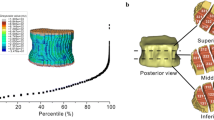Abstract:
Recent studies show that structural parameters of bone, obtained from computerized image analysis of radiographs, can improve the noninvasive determination of bone strength when used in conjunction with bone density measurements. The present study was designed to assess the ability of image features alone to predict the mechanical characteristics of bones. A multifactorial model was used to incorporate simultaneously a number of characteristics of the image, including periodicity and spatial orientation of the trabeculae. Fifteen pairs (29 specimens) of unembalmed human distal radii were used. The cancellous bone structure was determined using computerized spectral analysis of their radiographic images and the bones were tested to failure under compression. Multilayered perceptron neural networks were used to integrate the various image parameters reflecting the periodicity and the spatial distribution of the trabeculae and to predict the mechanical strength of the specimens. The correlation between each of the isolated image parameters and bone strength was generally significant, but weak. The values of mechanical parameters predicted by the neural networks, however, had a very high correlation with those observed, namely 0.91 for the load at fracture and 0.93 for the ultimate stress. Both these correlations were superior to those obtained with dual-energy X-ray absorptiometry and with the cross-sectional area from CT scans: 0.87 and 0.49 respectively. Our observation suggests that image parameters can provide a powerful noninvasive predictor of bone strength. The simultaneous use of various parameters substantially improved the performance of the system. The multifactorial architecture applied is nonlinear and possibly more effective than traditional multicorrelation methods. Further, this system has the potential to incorporate other non-image parameters, such as age and bone density itself, with a view to improving the assessment of the risk of fracture for individual patients.
Similar content being viewed by others
Author information
Authors and Affiliations
Additional information
Received: 22 March 1999 / Accepted: 12 April 2000
Rights and permissions
About this article
Cite this article
Wigderowitz, C., Paterson, C., Dashti, H. et al. Prediction of Bone Strength from Cancellous Structure of the Distal Radius: Can We Improve on DXA? . Osteoporos Int 11, 840–846 (2000). https://doi.org/10.1007/s001980070042
Issue Date:
DOI: https://doi.org/10.1007/s001980070042




